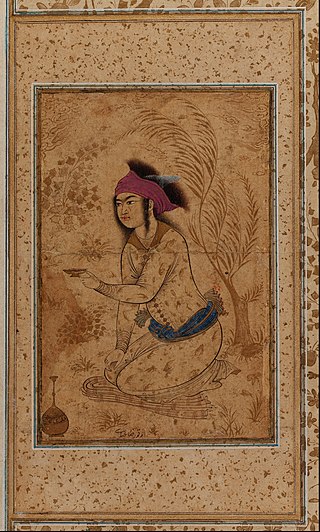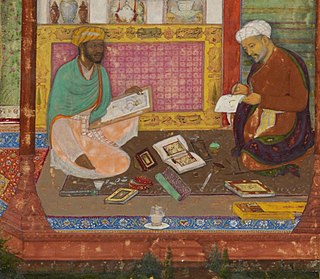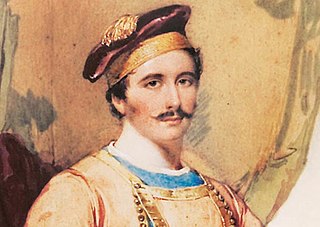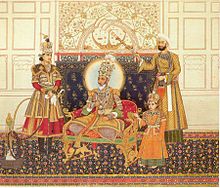
Bahadur Shah II, usually referred to by his poetic title Bahadur Shah Zafar, was the twentieth and last Mughal emperor and an Urdu poet. He was the second son and the successor to his father, Akbar II, who died in 1837. He was a titular Emperor, as the Mughal Empire existed in name only and his authority was limited only to the walled city of Old Delhi (Shahjahanbad). Following his involvement in the Indian Rebellion of 1857, the British deposed him and exiled him to Rangoon in British-controlled Burma in 1858, after convicting him on several charges. The title of Empress of India was subsequently transferred to Queen Victoria.

Awadh, known in British historical texts as Avadh or Oudh, is a historical region in northern India, now constituting the northeastern portion of Uttar Pradesh. It is roughly synonymous with the ancient Kosala region of Hindu, Buddhist, and Jain scriptures.

Akbar II, also known as Akbar Shah II, was the nineteenth Mughal emperor from 1806 to 1837. He was the second son of Shah Alam II and the father of Bahadur Shah II, who would eventually succeed him and become the last Mughal emperor.

Shah Alam II, also known by his birth name Ali Gohar, or Ali Gauhar, was the seventeenth Mughal emperor and the son of Alamgir II. Shah Alam II became the emperor of a crumbling Mughal Empire. His power was so depleted during his reign that it led to a saying in the Persian language, Sultanat-e-Shah Alam, Az Dilli ta Palam, meaning, 'The empire of Shah Alam is from Delhi to Palam', Palam being a suburb of Delhi.

Mughal painting is a South Asian style of painting on paper confined to miniatures either as book illustrations or as single works to be kept in albums (muraqqa), originating from the territory of the Mughal Empire in the Indian subcontinent. It emerged from Persian miniature painting and developed in the court of the Mughal Empire of the 16th to 18th centuries. Battles, legendary stories, hunting scenes, wildlife, royal life, mythology, as well as other subjects have all been frequently depicted in paintings.

Mir Syed Jafar Ali Khan Bahadur was a commander-in-chief or military general who reigned as the first dependent Nawab of Bengal of the British East India Company. His reign has been considered by many historians as the start of the expansion of British control of the Indian subcontinent in Indian history and a key step in the eventual British domination of vast areas of pre-partition India.

Saharanpur district is the northernmost of the districts of Uttar Pradesh state, India. Bordering the states of Haryana, Himachal Pradesh and Uttarakhand, and close to the foothills of Shivalik range, it lies in the northern part of the Doab region. It is primarily an agricultural area.

Farrukhnagar is a small town and municipality in Farrukhnagar tehsil of Gurugram district in the Indian state of Haryana. It is situated 21 kilometres (13 mi) from Gurgaon and shares its border with Jhajjar district. It is part of the Ahirwal region.

Company style, also known as Company painting is a term for a hybrid Indo-European style of paintings made in British India by Indian artists, many of whom worked for European patrons in the East India Company or other foreign Companies in the 18th and 19th centuries. The style blended traditional elements from Rajput and Mughal painting with a more Western treatment of perspective, volume and recession. Most paintings were small, reflecting the Indian miniature tradition, but the natural history paintings of plants and birds were usually life size.

Sir Thomas Theophilus Metcalfe, 4th Baronet, KCB was an East India Company civil servant and agent of the Governor General of India at the imperial court of the Mughal Emperor Bahadur Shah Zafar.

Rampur State was a 15 gun-salute princely state of British India. It came into existence on 7 October 1774 as a result of a treaty with Oudh. Following independence in 1947, Rampur State and other princely states of the area, such as Benares and Tehri Garhwal were merged into the United Provinces. Rampur state had its capital in Rampur city and its total area was 945 sq miles. Rampur state was founded by Ali Mohammad Khan's younger son Faizullah Khan.

A Muraqqa is an album in book form containing Islamic miniature paintings and specimens of Islamic calligraphy, normally from several different sources, and perhaps other matter. The album was popular among collectors in the Islamic world, and by the later 16th century became the predominant format for miniature painting in the Persian Safavid, Mughal and Ottoman empires, greatly affecting the direction taken by the painting traditions of the Persian miniature, Ottoman miniature and Mughal miniature. The album largely replaced the full-scale illustrated manuscript of classics of Persian poetry, which had been the typical vehicle for the finest miniature painters up to that time. The great cost and delay of commissioning a top-quality example of such a work essentially restricted them to the ruler and a handful of other great figures, who usually had to maintain a whole workshop of calligraphers, artists and other craftsmen, with a librarian to manage the whole process.

The Mughal Empire had a number of imperial flags and standards. The principal imperial standard of the Mughals was known as the alam. It was primarily moss green. It displayed a lion and sun facing the hoist of the flag. The Mughals traced their use of the alam back to Timur.
The town of Sautbad, known as Sheikhupur, is about 4 km from the centre of Badaun city across the river Saut, Uttar Pradesh, India and comes under Badaun Metro Area. It is 1 km from Budaun and will be part of the city in one year. The latitude and longitude of Sheikhupur are 28.1 (N) and 79.7' respectively.

The illuminated manuscript Khamsa of Nizami British Library, Or. 12208 is a lavishly illustrated manuscript of the Khamsa or "five poems" of Nizami Ganjavi, a 12th-century Persian poet, which was created for the Mughal Emperor Akbar in the early 1590s by a number of artists and a single scribe working at the Mughal court, very probably in Akbar's new capital of Lahore in North India, now in Pakistan. Apart from the fine calligraphy of the Persian text, the manuscript is celebrated for over forty Mughal miniatures of the highest quality throughout the text; five of these are detached from the main manuscript and are in the Walters Art Museum, Baltimore as Walters Art Museum MS W.613. The manuscript has been described as "one of the finest examples of the Indo-Muslim arts of the book", and "one of the most perfect of the de luxe type of manuscripts made for Akbar".
Qazi Ghulam Mustafa was one of the prominent noblemen during the Mughal empire. He was entitled 'Kar Talab Khan' by Bahadur Shah I. He was Emir and belonged to Ferozepur Jhirka.

William Fraser was a British India civil servant who was an Agent to the Governor General of India and Commissioner of the Delhi Territory during the reign of the last Mughal Emperor, Bahadur Shah Zafar. He was a brother of James Baillie Fraser.

Delhi Book or Delhie Book titled Reminiscences of Imperial Delhi is a collection of paintings done in Company style, commissioned by Sir Thomas Metcalfe in 1844. It contains 120 paintings by Indian artists, mainly by Mughal painter, Mazhar Ali Khan. The book was bought by the British Library in London.

The Fraser Album is a collection of paintings commissioned by the British Indian civil servant William Fraser. It is considered among the greatest masterpieces of Company painting. This work is an important documentation of the Mughal empire towards its end.
Ghulam Murtaza Khan (1760–1840) is a Mughal era, 19th century painter from Delhi. He worked under penultimate Mughal emperor Akbar Shah II. He worked under British officers, Skinner and William Fraser. The painting style was known as company style.






















